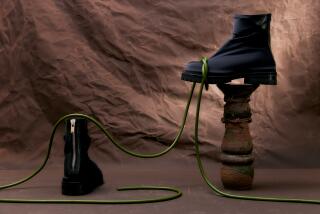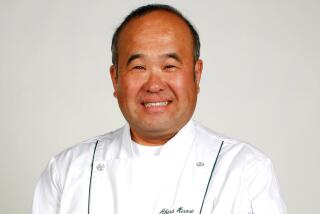Madame Mori: Japan’s Empress of Chic
- Share via
They call her Madame. Even her son, Kei, refers to Hanae Mori that way--although she’s sitting right across from him. Madame Hanae Mori; the title goes with the territory.
Now in her mid-60s, she is more than just the honored ancestor of Japanese fashion designers, more than the first Asian designer to open a salon on Avenue Montaigne--the famed couture row of Paris. Her name goes on the letterhead of a half-billion-dollar empire.
And fashion is only part of it.
There are newspapers and magazines (including Japanese versions of Women’s Wear Daily and Interview), a cable television network, restaurants, educational and cultural-exchange programs as well as the half-dozen or so fashion divisions. All of which have made Hanae Mori very rich. Quite possibly the richest designer in the world.
It’s a career built from stage costumes. She began in the 1950s, making clothes for Japanese films. Since then she has branched out to design for the opera and ballet. Right now she’s supplying some of the clothes Jacqueline Bisset will wear in an upcoming film set in Beverly Hills.
But costumes are not what Mori is best known for. Her hand-beaded evening dresses, covered with glittering butterflies, are her trademark. She chose the butterfly image, she said, because her life was transformed too, from traditional Japanese woman to international business mogul.
In Japan, where she does most of her business, she has 60 boutiques as well as a shopping-and-dining complex--the Hanae Mori Building--so popular it is noted on the nearby subway sign.
In Paris, she has two ready-to-wear boutiques along with her couture salon. And in the United States, major specialty stores carry her label, including I. Magnin and Neiman Marcus in Beverly Hills.
For all her power, Mori is a small and delicate woman who seldom looks up from the fingertips she keeps nestled in her lap. And despite any transformations, she hasn’t left Japanese tradition far behind. She even encourages her son, Kei, director of international affairs in her family-owned company, to answer questions for her, while she nods in quiet approval.
Despite her submissive stance, she took herself from Tokyo to New York in the mid-1960s and set up her first couture salon. She kept it for more than 10 years and would have stayed longer, “but when the economic situation in the States was not so good, store buyers in New York asked me to cut my prices,” she recalled. “That was not interesting to me.” (Mori couture ranges from $5,000 to about $50,000, ready-to-wear from $500 to $5,000.) And so, in the late ‘70s, she moved her salon to Paris. “I wanted to be an international designer. Paris is the center.”
The collection Mori showed in Los Angeles as part of Nisei Week, the annual Japanese cultural festival here, is a blend of French and Japanese fashion traditions. Some evening wear is hand painted to resemble Japanese screens. There are the signature beaded dresses with butterflies. And a favorite shape for daytime coats is the cocoon, also suggestive of traditional Japanese art.
But Mori’s spirited, daytime suits with peplums or swing backs, her classic couture-length skirts that just cover the knees and her way of completing every outfit with hat, gloves and high-heeled shoes, all point to her French affiliation.
She said her financial success is thanks to her husband and business partner, Ken Mori. And she explained that he entered the business to bail her out. It’s humorous to her now.
“I had big tax problems,” she said. “My husband wanted to help.” He had been running his own textile company. Now he is her chairman of the board.
Acquiring Awards
Obviously, Madame Mori’s part in the business, aside from creating clothes, is to acquire awards and honors. Her most coveted perhaps is her membership in the French Chambre Syndicale de la Haute Couture, the powerful organization behind the French fashion industry.
Another prize, garnered for her costume designs commissioned by the Paris opera and ballet, is the prestigious Croix de Chevalier des Arts et Lettres.
And in Los Angeles, she not only presented her fall collection as part of Nisei Week, she was the featured guest at this year’s celebration. “I was invited to take part by my friend,” Mori explained, glancing sideways in a gesture of shyness. Her friend turned out to be Toshiaki Ogasawara, chairman and publisher of Japan Times, the leading English-language newspaper in Japan.
She seems to have a lot of friends in high places. There’s Seiji Ozawa, conductor of the Boston Symphony Orchestra. “Madame Mori is his matchmaker,” Kei confided. “She introduced Seiji Ozawa to his wife.” And there’s Kenzo Tange, the Japanese architect who designed the Hanae Mori Building in Tokyo. And it was Mori’s friend and client, the late Princess Grace of Monaco, who first invited her to show her couture collection on the French Riviera.
“Fashion is an easy way to communicate,” Mori said. “People everywhere understand it.”
Having mastered that particular international language, she has made a life of flitting from one part of the globe to the other. She spends four months a year in Paris, primarily to launch her latest ready-to-wear and couture collections and inspect her two ready-to-wear boutiques. She makes regular stops in Manhattan, where she keeps an office. And she carries her couture collection to wealthy countries around the world--recently Kuwait and Thailand.
Social Luncheon
Good will may be part of what keeps her in flight. But her meetings with VIPs from I. Magnin and Saks at a social luncheon at the Regency Club during her stay in Los Angeles indicate something more.
“In spite of all she has done, she is not very well known in the United States,” Kei said. “Our priority is to pursue the American market for feminine working-women’s clothes.” A 32-year-old tycoon who owns homes in New York, Paris and Tokyo, he barely contains his high-spirited sense of fun, even when he’s talking business.
Madame Mori keeps a lower profile. “I want a Japanese identity,” she affirmed after her Regency Club luncheon. “I am Japanese after all.”
In the audience at her fashion show, a number of women wore kimonos, perhaps purchased at Mori’s Tokyo shopping complex. She still carries the traditional garment there, along with her Paris-inspired collections.
Despite the French connection, she doesn’t admit to any confusion about her loyalties. “The young Japanese designers who live in Paris are passionately avant-garde,” she said of iconoclasts Issey Miyake, Yohji Yamamoto and Rei Kawakubo for Comme des Garcons. “I am not. I love to follow the traditional way.”






